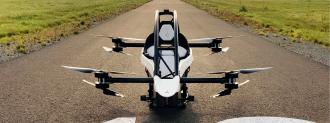This article is an installment of Future Explored, a weekly guide to world-changing technology. You can get stories like this one straight to your inbox every Thursday morning by subscribing here.
You can now buy a flying car for $92,000 — and you don’t need a pilot’s license to operate it.
On October 21, Sweden’s Jetson Aero launched the Jetson One, a single-seat flying car with 20-minute flight times and a top speed of about 63 mph. It has already sold all 12 of the electric vehicles in its first production run (to be delivered in fall 2022), and it’s now taking orders for 2023.
The vehicles will be delivered about 50% assembled, and customers must finish putting them together themselves.
That’s how Jetson is getting around the need for pilot’s licenses — they aren’t required for homebuilt single-seater aircraft. This approach makes the builder — not Jetson — responsible for any accidents, which doesn’t exactly inspire confidence.
The Jetson One can’t be flown at night, over city traffic, or in restricted air space, either, so right now it’s more like a really expensive, really cool toy than an alternate transportation option.
But if we can do this, what’s preventing the launch of flying cars that can replace our daily commutes?
A crowded space: Today, more than 150 companies are developing some versions of a flying car, and though designs vary, most are electric vehicles that take off and land vertically like helicopters (eVTOLs).
These flying cars wouldn’t require a runway, so they could use parking garages and building rooftops as landing pads, ferrying handfuls of people across cities like airborne Ubers. We might even be able to make larger versions that could provide mass transit in the sky.
This would require less upfront cost than building the infrastructure needed for more ground transportation — roads, railways, subway lines, etc. — and it would be more flexible.
“When cities change, as populations move, the routes can move in a way that trains and rail, or highway infrastructure, cannot,” Harrison Wolf, the World Economic Forum’s Lead for Aerospace and Drones, said in 2020.
“Aircraft flying in these layers will interact, and that’s where things get tricky.”
Savvy Verma
The hope is that the flying cars will be ready in time to prevent an increase in traffic congestion that’s expected to follow the flow of more people into urban areas (over the next 30 years, the share of people who live in cities is expected to increase from 50% to 70%).
Congestion has a negative impact on local economies, residents’ quality of life, and the environment (if the vehicles being used are powered by fossil fuels, which they overwhelmingly are), so less of it would have a myriad of benefits.
Safety first: But deployment of flying cars is notoriously slow moving.
This is partly due to the technical challenge of developing flying cars with useful ranges (we still need lighter batteries with greater capacity), but also the need to ensure passengers, and people on the ground, are safe when many eVTOLs are in flight at one time.
“The space where these aircraft will operate is sandwiched between low-flying drones and the traditional airspace high above,” Savvy Verma, lead for airspace procedures at NASA’s Air Traffic Management eXploration (ATM-X) project, said in January.
“Aircraft flying in these layers will interact, and that’s where things get tricky,” she continued.
The challenge: So, how do we balance our need for innovative urban transportation options with our need for passenger safety? One way is to look at the last invention to shake up personal transport: the automobile.
When the first production automobiles hit American roads in 1895, anyone could drive them pretty much however they wanted to — there were no speed limits, stop signs, driver’s licenses, drunk-driving laws, insurance, or traffic police.
The vehicles themselves weren’t regulated, either — in fact, the U.S. wouldn’t create its first federal safety standards for motor vehicles until 1968 — and there were almost 22 deaths per 100 million miles driven in 1923.
Does the presence of these regulatory bodies mean that flying car innovation will be stifled by red tape? Not necessarily.
Today, we’re down to just 1.2 deaths per 100 million miles, thanks to a combination of safer vehicles (better design, seat belts, airbags, crumple zones, etc.), more experienced drivers, traffic regulations, and better road infrastructure.
The flying car industry isn’t going to repeat the ground car industry’s learning curve for a number of reasons, the main one being it legally won’t be able to — unlike when cars first hit roads, we now have agencies in place to regulate eVTOLs and where they can fly.
Does the presence of these regulatory bodies mean that flying car innovation will be stifled by red tape? Not necessarily.
Leaning into regulations: While regulations are usually seen as the antithesis of innovation, they may actually help speed up the adoption of flying cars — developers can point to their vehicle’s ability to meet the standards as evidence of their safety.
“If we don’t take safety and security seriously, then society won’t trust this,” Wolf said. “The thing that matters most is that society accepts any form of new mobility or transportation. Without that trust, it won’t scale and the price will never come down.”
We have an existing aviation industry, with leaders who are already working together to establish technical standards for eVTOLS that, if accepted by regulators, should make it easier for developers to get new vehicles certified.
Certification confirms that a craft meets the FAA’s safety expectations, and as it stands, some flying car designs are so unique, creators would need to seek out multiple exemptions before their vehicles could be certified.
“The thing that matters most is that society accepts any form of new mobility or transportation.”
Harrison Wolf
There are certain existing rules for aircraft rotors and wings, for example, that some eVTOLs don’t conform to, but that doesn’t mean they can’t be flown safely — the new standards would focus more on the performance of the vehicles than their individual parts.
“[T]he performance-based standards are huge in letting electric innovations take advantage of a wide array of configurations that are non-traditional,” Ed Lovelace, CTO of electric aircraft pioneer Ampaire, said of the collaborative effort.
“This allows for different architectures and avoids stifling innovation,” he added.
“You have more commitment, top to bottom, to bring these technologies to viable life than I’ve ever seen.”
Dan Elwell
Eventually, the best designs should emerge from this process — the batteries in flying cars, for example, are incredibly disparate right now, but once the industry figures out what works, we’ll see more standardization naturally.
“There are lots of solutions to creating and distributing an energy source and so it is very hard to standardize at this point, but this is part of being at the cutting edge and over time it will become clear what the best way is,” Tom Gunnarson, regulatory affairs lead for eVTOL developer Wisk, said.
Regulators, meanwhile, say that they’re ready to welcome flying cars — Dan Elwell, then-acting administrator of the FAA, said in 2018 that the agency was doing its best to match the pace of developers, and in 2021, it cleared its first flying car for takeoff.
“You have more commitment, top to bottom, to bring these technologies to viable life than I’ve ever seen,” Elwell said.
Editor’s Note, 11/5/21: This article has been edited to correct the year production automobiles reached the U.S.
We’d love to hear from you! If you have a comment about this article or if you have a tip for a future Freethink story, please email us at [email protected].






